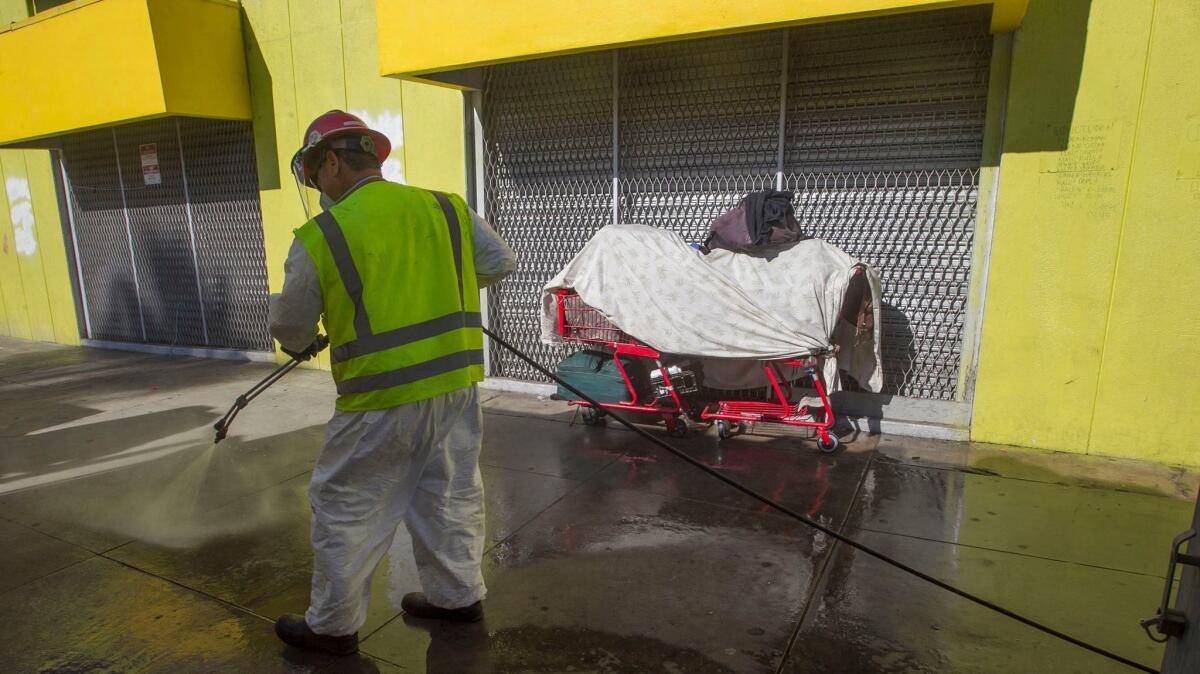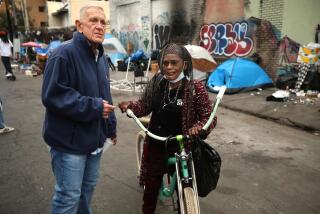Grim conditions in public restrooms hurt fight to halt deadly hepatitis outbreak in San Diego

Dozens of homeless people on Thursday morning were sprawled out in the courtyard on 15th and Commercial streets outside of Father Joe’s Villages in San Diego.
The crowd — some listening to music on headphones and most toting multiple pieces of luggage — gathered for a free lunch doled out regularly by the homeless shelter.
Frazier Johnson waited patiently among them as a line for food began to form around 11 a.m. The calm 47-year-old wore a fresh long-sleeved T-shirt and a white goatee framing a healthy looking face.
Johnson said he closely tracks his meal times because they determine when he will need to be near one of the public restrooms accessible to the down-and-out.
“If you don’t, then you’re going to have a situation on your hands,” he said with a soft smile and dark, lucid eyes.
Johnson, who arrived from Texas a few months ago, said finding a clean bathroom in downtown San Diego can be challenging. However, he doesn’t blame local officials.
“There’s not enough bathrooms, but if the city puts in bathrooms, you have a whole lot of homeless people that don’t appreciate it,” he said. “They’re going to go in there and do drugs. They’re going to mess the place up. So the city has a heck of a problem to overcome.”
One of the most frequently used public restrooms is located just steps away through the doors of St. Vincent de Paul Village, which as part of Father Joe’s Villages is the largest residential service provider for the homeless in the county.
The state and availability of such facilities has recently received intense scrutiny as the region grapples with a massive outbreak of hepatitis A that has killed 16 and stricken 444 people. Health officials believe that the eruption of cases, which has now spread to Santa Cruz and Los Angeles, proliferated among the homeless as a result of poor sanitation and drug use.
Deacon Jim Vargas of Father Joe’s Villages had just finished giving his second news conference in as many days that morning, detailing efforts to keep facilities clean and combat the potentially deadly virus.
“The nature of public restrooms in general is it’s a messy business,” Vargas said. “We are now having to clean those restrooms every two hours, far more than you would normally clean a restroom because of the clientele we have here. Some of them have mental health issues. Some have substance abuse issues. And that plays itself out in these public restrooms.”
The men’s room has two stalls, three urinals and a foul smell despite having recently been washed down. Some homeless people said that, like many restrooms that are open 24 hours a day, it’s not a place they frequent after dark because it’s a hot spot for meth and heroin use.
Large fans are to be installed in the restrooms within a few weeks for the sole purpose of preventing people from using lighters in the facility, Vargas said, pretending to cook drugs in a spoon with his hands. “It will blow out the flame and they won’t be able to accomplish their goal there of shooting up, basically.”
That could help keep the bathroom clear for folks who want to use it for its intended purpose, such as Marcos Vasquez. The 38-year-old has been homeless on and off for the last three years, and says that although he does his best to make it to the public restrooms, many don’t.
“A lot of them are alcoholics that are too drunk or too wasted to go down the street and time it,” Vasquez said of those who defecate in public, either into trash bags or directly onto the street. “They don’t care.
“I’ve had to clean the sidewalks myself off where I camp at,” he added. “It’s gross.”
Mayor Kevin Faulconer has ramped up efforts in recent weeks to combat the outbreak of hepatitis A. More than 28,000 people have received vaccinations, and crews have started power washing and bleaching sidewalks downtown.
The city recently added four portable toilets at the corner of C Street and 1st Avenue and another four at 14th and G streets. The facilities are cleaned at least twice a day and monitored around the clock by security guards. City officials said they would install another bank of such toilets in the East Village next week.
Homeless residents currently have access to about five 24-hour public restrooms in the city’s urban core. There are more than a dozen other such facilities in downtown, including those open only during the day and those along the distant waterfront. City officials said they are looking for locations to place additional temporary toilets.
“Downtown property owners with space for portable restrooms are encouraged to contact the city with their willingness to be part of the solution to this public health emergency,” said Katie Keach, director of communications for the city. “If a site is workable and near at-risk populations, the city will arrange for the installation, maintenance and security of each restroom.”
Smith writes for the San Diego Union-Tribune.
Smith writes for the San Diego Union-Tribune.
More to Read
Sign up for Essential California
The most important California stories and recommendations in your inbox every morning.
You may occasionally receive promotional content from the Los Angeles Times.










